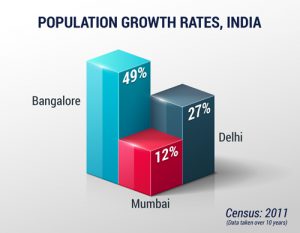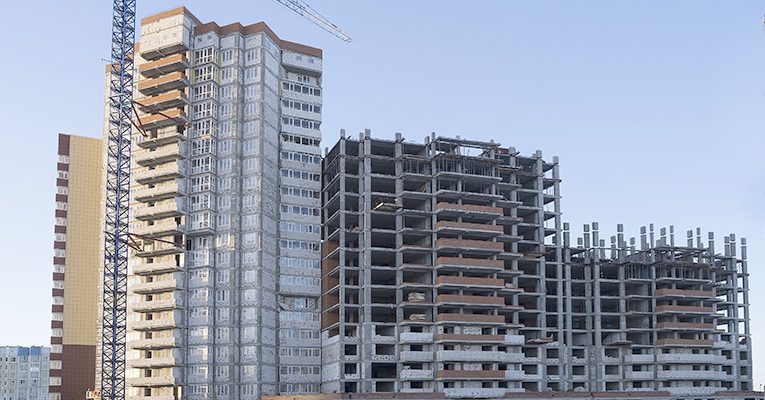Delhi and Mumbai exert profound influence over the rest of India—one as the seat of government, and the other as the financial capital. They are also the two most populous cities in the country. It would seem natural for investors, eager to tap into the potential of India’s growth story, to imagine that the property market in either city is a sure bet. The problematic logic is this: as the country’s economy moves in an upward trajectory, doesn’t it stand to reason that residential and commercial property values in the two largest urban centers will climb as well? Shouldn’t a real estate investor buy now, comfortable in the assumption that prices in Mumbai and Delhi will keep rising over time?
Popular as this reasoning may be, it neglects some of the key tenets of property investing. A closer look at the fundamentals in Mumbai and Delhi would give most investors pause. To offer the most meaningful gains, real estate purchases should be in geographies with low current prices, high salary growth, and rapidly expanding populations. High-potential cities such as Bangalore and, to a lesser extent, Pune and Chennai, score well on all three tests, but their larger counterparts do not. Put another way, while the Indian growth story is hot, property investors who bank on Mumbai and Delhi may find themselves left out in the cold.
What’s wrong with the picture in these two metropolises? Simply stated, both are awash in red flags that investors should look out for: high prices, sluggish growth, excessive inventory, and harmful business practices.
Current prices in both cities are tremendously elevated. The country’s most premium market is Mumbai, where roughly one-third of newly launched units last year carried a ticket price above Rs 1 crore. Yet these outlays are unwarranted and unsustainable vis-à-vis the average income of residents. The typical home in Mumbai costs an eye-popping 20 times the homeowner’s income. Delhi’s rates are not far behind. (By contrast, homes in other Indian cities run an average of five to seven times the homeowner’s income.)
The sky-high price levels do not reflect genuine demand by end users. Data suggests that as many as 75% of residential units in Mumbai are purchased for pure investment purposes rather than for actual dwelling. Investors have bought large numbers of flats in anticipation of future growth, and this artificial demand has driven up ticket prices. But is the expectation of future windfall gains justified?
Not if current population and job growth is any consideration. According to the 2011 Census of India, Mumbai’s population grew by 12% and Delhi’s by 27% over the previous decade. When compared across the 20 largest cities in India—especially Bangalore, which experienced a blistering 49% increase during the same period—Mumbai and Delhi rank near the bottom in pace of growth.
 Of greater relevance, neither city has been the magnet for urban professionals that growth centers such as Bangalore, Pune, and Chennai have been. Multinational corporations, startup companies, and other job creators have in recent years tended to favor lower-cost areas to establish their presence. The corresponding surges in population and in white-collar salaries in emerging economic hubs have not occurred on nearly the same scale in the nation’s two largest cities. One interesting way to track this phenomenon is to examine the absorption of Grade A office space. For example, in 2014 office space absorption in Mumbai barely crossed half of that in Bangalore (4.5 vs 8.9 million square feet, respectively), despite Mumbai having more than twice Bangalore’s population.
Of greater relevance, neither city has been the magnet for urban professionals that growth centers such as Bangalore, Pune, and Chennai have been. Multinational corporations, startup companies, and other job creators have in recent years tended to favor lower-cost areas to establish their presence. The corresponding surges in population and in white-collar salaries in emerging economic hubs have not occurred on nearly the same scale in the nation’s two largest cities. One interesting way to track this phenomenon is to examine the absorption of Grade A office space. For example, in 2014 office space absorption in Mumbai barely crossed half of that in Bangalore (4.5 vs 8.9 million square feet, respectively), despite Mumbai having more than twice Bangalore’s population.
Excessive inventory is another concern. Developers are sitting on a disproportionate supply of homes, most particularly in Delhi. Out of the country’s six major property markets (which include Bangalore, Pune, Chennai, and Hyderabad), Delhi accounts for one-third of unsold new units. This is true even though most of the unsold new homes in Delhi are mid-range and therefore more accessible.
 Developers in Mumbai, too, are struggling with surplus units. According to recent assessments, at the current pace of sales it would take 45 months to clear out existing inventory in Mumbai. Related to this, new developments are far more likely to be behind schedule in these two cities, presumably because developers are slowing the construction process down. Experts estimate that more than 50% of new projects in Mumbai and Delhi are behind by one year or more.
Developers in Mumbai, too, are struggling with surplus units. According to recent assessments, at the current pace of sales it would take 45 months to clear out existing inventory in Mumbai. Related to this, new developments are far more likely to be behind schedule in these two cities, presumably because developers are slowing the construction process down. Experts estimate that more than 50% of new projects in Mumbai and Delhi are behind by one year or more.
Compounding these negative market-related factors are other reasons why investors may want to shy away from Mumbai and Delhi. Both are known for a lack of transparency and extensive use of “black money” in real estate transactions. As a consequence of these practices, buyers of new properties have to exercise greater caution—for example, purchasing only when a development is completed or on the verge of completion. This means that buyers in Mumbai and Delhi may take on undue risk if they wish to obtain the lower prices offered during the early stages of a project—which is precisely when the most significant gains are locked in.
Indeed, it takes a savvy investor to navigate the minefield of disadvantages in Mumbai and Delhi and to spot a truly lucrative deal. Both bear the characteristics of a bubble, including lackluster growth coupled with high prices. Despite these cities’ formidable influence in administrative, historical, cultural, and financial spheres, they are not poised to be leaders in real estate wealth creation. Investors looking for more substantial returns at a much lower risk will be far better off to focus on emerging growth centers instead.
